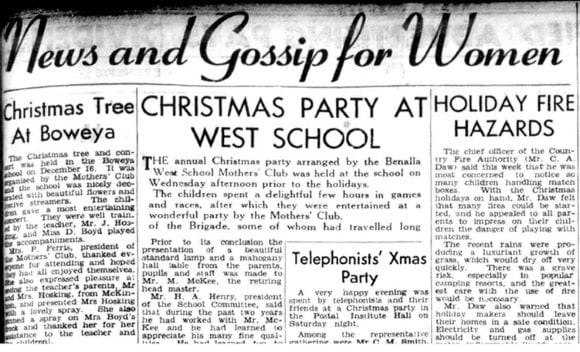Pioneering mothers in public education
During the 150th anniversary year of public education in Victoria, International Women's Day (Tuesday 8 March 2022) #BreakTheBias, was a great opportunity to take a closer look at some of the important women whose stories are often overlooked in the history of education. School mums.
There wouldn’t be anyone, anywhere, who went to an Australian school who doesn’t fondly remember the canteen mums, the reading-help mums and the school-excursion mums. Mums have always been at the forefront of the educational experience in Victoria. Their achievements and stories have made a lasting impact and deserve celebrating.
Parents started the first European schools in Victoria. The first European schools in Victoria were started by parents. In the mid-1800s, a community would apply to the Board of National Education for a teacher, but they would have to provide the school building. In 1872, with the passing of the Education Act, the responsibility for both was taken over by the Education Department.
In 1917, Emmaline Pye, a lecturer at the Melbourne Teachers’ College suggested to Lillian Horner, a teacher at Princes Hill State School, that she invite local mothers into the classroom to help with reading. The idea was so popular that by 1925 there were 100 Mothers’ Clubs. These Mothers' Clubs banded together to become the Victorian Federation of Mothers’ Clubs (VFMC). They had membership badges printed with ‘We Serve the Children’.
The members soon realised there were better ways to support their children’s education. They began fundraising to provide equipment for their schools as well as for needs in their communities.
1930s
In 1930, the Argus newspaper described the Victorian Federation of Mothers’ Clubs (VFMC) as the:
'means whereby the opinions and convictions of the parents of school children can be registered and an avenue through which these opinions may reach the Education Department and the Minister'.
Mothers noticed that the rate of girls finishing school was low, so the VFMC ran a study tour for 37 teenage girls to travel to Sydney and the new Parliament House in Canberra. The study tour showed them the range of career opportunities if they stayed at school and went to university.
The Depression years led to government cutbacks to schools, and many families suffered hardships. During these years, memberships of Mothers' Clubs grew, and fundraising and community activism increased. Mothers’ Clubs were very active in providing school lunches and clothing for needy children. Despite their successful fundraising, the committees were not given control over any of the funds they raised. Two-hundred members unsuccessfully appealed to the Education Minister for control of the funds.
1940s
During the 1940s, the mothers of the Victorian Federation of Mothers’ Clubs (VFMC) were very active in fundraising for war work. They also advocated the need for child endowment, introduced by the Commonwealth Government in 1941. The Child Endowment Act 1941 provided that a sum of 5 shillings per week, for each child after the first under the age of 16 years, be paid directly to the mother.
'At the 1946 conference, then Premier John Cain Snr congratulated the mothers of Victoria on their ‘magnificent work for the younger generation’.
1950s
An internal survey showed that in 1956, Victorian Federation of Mothers’ Clubs (VFMC) members had raised 135,000 pounds for schools. Using the Reserve Bank’s inflation calculator, that is worth $4.6 million in today’s figures.
The VFMC continued to advocate for issues that affected their local schools. In 1959, 300 mothers from 38 regional schools met in Bendigo. They discussed many issues including school toilets, dangerous crossings, needlework teaching, fluoridation, more federal aid, the danger of lead and poor-quality school uniforms.
The VFMC were pioneers supporting sex education by organising ‘mother and daughter evenings’.
In the late 1950s, the VFMC changed its name to the Victoria Federation of State School Mothers’ Clubs (VFSSMC). By 1958, the VFMC represented 850 Mothers’ Clubs.
1960s
During the 1960s the Victoria Federation of State School Mothers’ Clubs (VFSSMC) attended state and national conferences demanding Federal Government funds for state schools. They highlighted the poor conditions of school buildings and demanded better maintenance and new buildings. They advocated for libraries for schools, smaller classes, specialist teachers and clerical help, as well as a major focus on the safety of children at school crossings.
In 1966 they were finally able to spend the funds they had raised on the school, rather than giving it to the school.
1970s
The increase in working women, and single-parent families meant that women had less time in the day to devote to club activities. Mothers' Clubs were replaced by Parents Clubs becoming the Victoria Federation of State School Parents’ Clubs (VFSSPC). At the same time School Councils were established with elected parents and teachers, these worked alongside Parents Clubs and were responsible for some of the local management of the school.
In 1976 when the Minister of Education, Lyndsay Thompson, congratulated the VFSSPC on their 50 years anniversary Joan Kirner was its president.
He stated:
‘As valuable as their fund raising efforts have been, mothers have perhaps formed an even more important role. They have indeed acted as a bridge, a line of communication between the school and the rest of the community. Observing their recent name change from VFSSMC to VFSSPV he mentioned, ‘In these days of non-discrimination between the sexes it is most pleasing to note that it is no longer necessary to become a mother or even look like a mother to gain membership’.
1980s
The Victoria Federation of State School Parents’ Clubs (VFSSPC) saw their long-held policy against corporal punishment was finally upheld as the government abolished it in their schools. They had also advocated for increased power for school councils, and they were able to select principals.
1990s
VFSSPC were active in organising rallies to protect public education. There were education cuts from state and federal budgets which resulted in major school closures and teacher redundancies. There were competing demands for parents to pay a levy for education which was strongly and successfully opposed by the Victoria Federation of State School Parents Clubs (VFSSPC).
2000s to today
In 2000 the VFSSPC became Parents Victoria.
In 2003, Parents Victoria’s campaigning to reduce the speed limit near schools, saw the government introduce the 40 kilometre per hour zones.
Today Parents Victoria pursues the broad goal of ensuring that education remains free, compulsory, secular and available to all, regardless of what political party is in power.
As it began in 1925 as a women’s organisation in the Victorian community, it continues today as a peak body supporting public education and an important community organisation for women to be influential in the Victorian community.
As the organisation approaches it’s 100th birthday.
'There will always be a need for such a body to ensure that parents continue to have a voice in the education of their children. There will always be improvements to be sought and battles to be fought’.(Crowle & Murray, 2012)
Female pioneers in Victorian education you should know about
From school principals, community activists, teachers, trade unionist to Aboriginal rights activist. Learn more about our female pioneers.
Molly Brennan – School Principal and community activist
Frances Barkman – Teacher and welfare worker
Mary Bluett – Teacher and trade unionist
Patricia Edgar – Teacher and children’s television activist
Susan Hopgood – Teacher and trade unionist
Betty Lawson – Teacher, equal pay campaigner and trade unionist
Clara Weekes – Teacher, pacifist, suffragist, equal pay campaigner and trade unionist
Margaret Williams Weir – Teacher, Naval Officer and Teachers
The sources for these stories and for more women teachers' biographies please see: The Encyclopedia of Women and Leadership in Twentieth Century Australia.(opens in a new window)
This article is based on information from Dr Deborah Towns OAM and her book ‘The Largest Women’s Organisation’. Mothers' Clubs working in the Victorian community’. Dr Towns is an Honorary Research Fellow, Department of Management and Marketing, Faculty of Business and Economics, University of Melbourne(opens in a new window).
- Deborah Towns (2021) ‘The Largest Women’s Organisation’ The Victorian Federation of Mothers’ Clubs’ 1920s-1970s’, paper delivered at the Australian and New Zealand History of Education Conference, Melbourne 2021
- Deborah Towns & John Andrews (2017) ‘Parents, School Councils, Parents Victoria (PV) & Victorian Council of School Organisations (VICCSO), chapter in John Andrews & Deborah Towns , ‘A Secondary Education For All’? A History of State Secondary Schooling in Victoria’, Australian Scholarly Publishing, 2017.
- Megan Crowle and Heather Murray (2012), Our Children, Our Concern, 1925-2012, Parents Victoria, Melbourne, 2012.
- Deborah Towns (2010) Chapter 8, ‘‘When I was Minister for Education”, Caroline Hogg and Joan Kirner: teacher politicians, equity, girls’ education 1982-1990’ in “Our Own Sphere”, Women Teachers and the Education Department of Victoria, 1880s -1980s’ PhD Thesis, La Trobe University, 2010.
- Joan Kirner(1996), ‘From Mum to Minister’, Education Speeches, 1973-1984’, manuscript, State Library of Victoria.
- Heather Murray (Editor), Victorian Federation of State Schools Parents Clubs (1976), Victorian Federation of State Schools Parents Clubs Newsletter, Special Anniversary Edition (1976), available in State Library of Victoria.
- Victorian Federation of Mothers' Clubs (VFMC), VFMC Quarterly Review, various dates from 1930s to 1960s.
Updated











